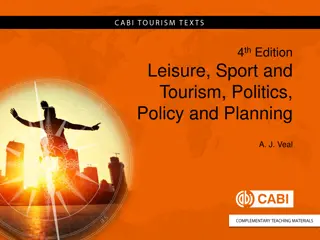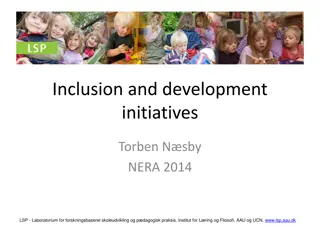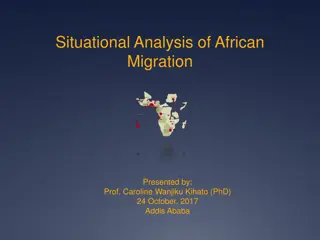Challenges and Realities of Migration: Addressing Human Rights and Social Inclusion
People migrate for various reasons, seeking better opportunities and escaping poverty or conflict. Globalization has facilitated migration, but xenophobia and discrimination persist. Migrants face illegalization, exploitation, and violation of human rights. Hostile attitudes towards immigrants are prevalent globally, with factors like education and employment status influencing perceptions. It is crucial to combat discrimination and promote social inclusion for all migrants.
Download Presentation

Please find below an Image/Link to download the presentation.
The content on the website is provided AS IS for your information and personal use only. It may not be sold, licensed, or shared on other websites without obtaining consent from the author.If you encounter any issues during the download, it is possible that the publisher has removed the file from their server.
You are allowed to download the files provided on this website for personal or commercial use, subject to the condition that they are used lawfully. All files are the property of their respective owners.
The content on the website is provided AS IS for your information and personal use only. It may not be sold, licensed, or shared on other websites without obtaining consent from the author.
E N D
Presentation Transcript
HUMAN RIGHTS OF ALL MIGRANTS, SOCIAL INCLUSION, COHESION AND ALL FORMS OF DISCRIMINATION, INCLUDING RACISM, XENOPHOBIA, GENDER DISCRIMINATION AND INTOLERANCE William Muhwava UNECA
19TH SEPTEMBER, 2016 UN HIGH LEVEL MEETING ON REFUGEES AND MIGRANTS 1. Commitment to launch a process to develop a Global Compact on Refugees 2. Commitment to launch a process to develop a Global Compact on Migration 3. Welcomed IOM as a related agency to the UN 4. Secretary-General s Together Campaign to counter Xenophobia
INTRODUCTION People move not only to escape poverty, environmental disasters or violent conflict, but also to pursue their aspirations for a better life. Globalization has opened new avenues for migration distances have shrunk and information on opportunities are easily available and widely shared. However, as migration increases there are increases in xenophobia & discrimination tendencies
MIGRATION PATTERNS About 31 million Africans, or little more than 3% of the continent s population, have migrated internationally, that is outside the borders of their own countries. The majority of migrants from Africa go to other African countries (as shown in the next slide). Only about 18% of migrants from Africa go to Europe, and of the total migrant stock in Europe, less than 12% are from Africa. Yet, the dominant misconception is that an overwhelming number of Africans are waiting to cross into Europe. The misconception has fuelled Emotive reactions and policies Harmful responses to migration (deportation, imprisonment) Anti-immigrant issue as an election campaign
HUMAN RIGHTS ISSUES Illegalization of migrants Exploitation of migration and migrants: which includes low wages, inhuman working conditions especially for domestic workers Dichotomization of human rights Indivisibility of Rights vs Contemporary Protection Regimes: where people facing denial of economic, social and cultural rights are not recognized compared to those facing political rights. Protection versus Control: Racism, xenophobia and discrimination anti-foreigner hostility include incitement to and actions of overt exclusion, hostility and violence against persons explicitly based on their perceived status as foreigners or non-nationals association of migrants, immigrants, refugees and displaced persons with crime and criminality utilization of terminology of illegality to characterize persons
WHAT DOES THE DATA SAY? Increasing or stable levels of hostile attitudes to immigrants both in Africa and globally Individual-level links from lower education and labor-force status to more hostile attitudes Cues given by national and local government officials and other political forces exacerbate these sentiments Anti-immigrant attitudes and actions differ Between regular and irregular immigrants Skilled and unskilled immigrants Racial, ethnic, cultural, and religious hierarchies
THE RIGHT TO MOVE Two Fundamental Questions Given the degree of regional and global integration, and the increasing freedom of movement of capital, goods, and services in an unequal world, must not human beings themselves also be guaranteed freedom of movement, however utopian such a proposal might seem to be? Isn t freedom of movement among the global public goods which should be the common heritage of the human family? Raised by Minter (2011)
CONTINENTAL FRAMEWORKS Fundamentals of Pan-Africanism has been a borderless Africa which allows free movement of people within the continent The free movement of persons, along with goods and services is articulated in the Abuja Treaty establishing the African Economic Community (1991) as a key element in achieving the goal of regional integration on the continent. In implementing the Abuja Treaty, the African Union (AU) has adopted policy frameworks, such as the Migration Policy Framework for Africa (MPFA), that provide guidance to member states and Regional Economic Communities (RECs) on the development of policies that promote integration through migration as part of efforts to strengthen migration governance for regional economic integration and inclusive development.
STATUS OF IMPLEMENTATION IN ECOWAS Protocol on Free Movement of Persons and the Right of Residence and Establishment, adopted in 1979 by ECOWAS entering into force in 1980. Includes freedom of movement of people, a common passport and the right of residence and establishment
STATUS OF IMPLEMENTATION IN SADC Drafted a protocol on the free movement of people in 1993 1994. This was strongly opposed by the South African government, who feared the consequences of open borders on unemployment, xenophobia and irregular migration These arguments were contested, they were sufficient to reduce the initiative to a much less ambitious version.
VISA OPENNESS INDEX African countries are on average more closed off to each other than open, making travel within the continent difficult. Africans need visas to travel to 55% of other countries. Africans can get visas on arrival in 25% of other African countries. Africans don t need a visa to travel to 20% of other African countries.
CHALLENGES FOR IMPLEMENTATION OF EXISTING PROTOCOLS Visa regimes and border restrictions still prevents free movement of persons. The costs of visas are also excluding the poor who cannot afford. Security concerns and fear of being overwhelmed by the presence of irregular migrants and foreign workers which often leads to tensions with nationals, especially in periods of significant unemployment also preclude free movement. Some governments have apprehension about the impact of migrants on national identities and the socio-cultural dynamics of host communities. Free movement of persons continues to be balanced against the political and economic interests of individual member states. National policies, legislative instruments and institutions and mechanisms designed to manage cross-border migration are inevitably couched in protectionist language.
CONSEQUENCES OF RESTRICTING MOVEMENT Exploitation and abuse of migrants rights especially women who constitute about 85% of cross-border traders in Africa. Migrant deaths across world borders have increased drastically in the past few years. IOM estimates that over 40,000 migrants have died since 2000 and the organization has called on all governments to address what it describes as an epidemic of crime and victimization .
CONCLUSIONS GeneralConclusion Overall there is agreement amongst African states, from the regional consultative meetings, that it is essential to ensure the protection of migrants whether they are in transit or have settled in a receiving state. Africa has mixed migration streams e.g. refugees, economic migrants, migrant labourers, irregular migrants, but all migrants, regardlessoftheirmigrationstatus deservetheprotectionoftheirhuman rights. The gap between stated principles and practice, together with the relatively low level of international attention given to violation of migrants rights, make it important not only to consider the legal frameworks in place but also the underlying assumptions and climateofopinion that affecttheprospectsfor change
ACTIONABLE COMMITMENTS: CONTINENTALLY Speed up the implementation of continent-wide visa free regimes including issuance of visas at ports of entry for Africans and based on the principle of reciprocity where those countries that offer free movement should receive same. Expedite the operationalization of the African Passport that would, as a start facilitate free movement of persons that will be issued by Member States. Regional integration is a sine qua condition for African countries to compete effectively in a changing global economy. Ratification and implementation of agreed mechanisms on regional economic integration, free movement of persons and sustainable inclusive development is essential.
ACTIONABLE COMMITMENTS: CONTINENTALLY The African continent is now well equipped with a strategy, Migration Policy Framework for Africa and a politically validated programme of action, Joint Labour Migration Project spearheaded by the AUC with coordinated support from the ILO, IOM and ECA, it now needs to concentrate its efforts on working towards an operational roadmap. Further, the Addis Ababa Declaration on Population and Development beyond 2014 commits to protecting and fulfilling the rights of all migrants including migrants seeking opportunities, internally displaced people and forced migrants as a result of humanitarian crisis, natural disasters and conflicts and victims of human trafficking, through policy and programmes that ensure their access to work and basic social services as well as enhancing the capacity of security and law enforcement agencies to protect the rights of such persons.
ACTIONABLE COMMITMENTS: INTERNATIONALLY States should strengthen protection mechanisms that protect the rights of all migrants, particularly those most vulnerable women, children and the elderly. This would require: Observing international human rights frameworks Upholding the humanitarian principles of migration Ensuring the safety and dignity of all migrants Protection for migrant workers rights and vulnerable groups Counter trafficking and smuggling coordination efforts Protection of rights of citizens abroad (Diaspora) Combating abuses and exploitation of migrants Addressing special needs of migrants in vulnerable situations Establishing means of redress for migrants subjected to human rights violation including access to justice Establishing deterrent mechanisms for perpetrators of human rights abuse against migrants
States must ensure social cohesion and integration of migrants into host communities. This includes not only social integration but economic integration as well. This could be done through the following initiatives: Guaranteeing migrants access to the same services as host by 2030 to achieve no one behind Ensuring migrants have access to redress including justice, legal representation as locals by 2030 Promoting decent work with special emphasis on female migrants Actively ensuring inclusion of migrants in host communities through mainstreaming migrants into national and local development plans. Actively discouraging all forms of discrimination, racism, xenophobia, and other forms of intolerance against migrants Implementing social awareness campaigns to counter negative perceptions of migrant States to implement social awareness campaigns to counter negative perceptions of migrants.























